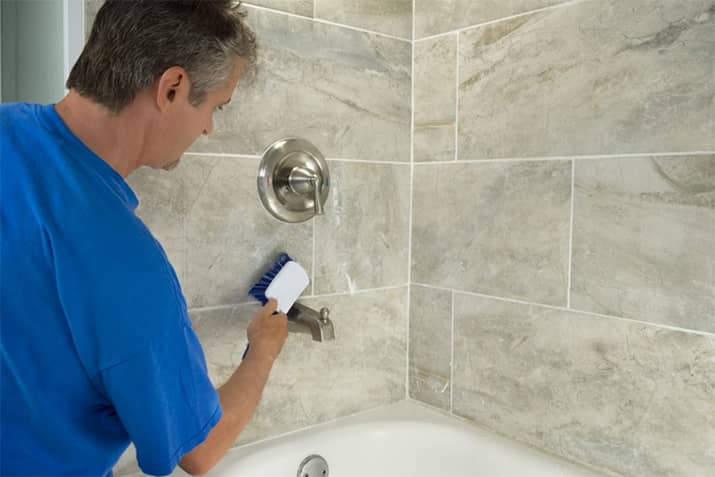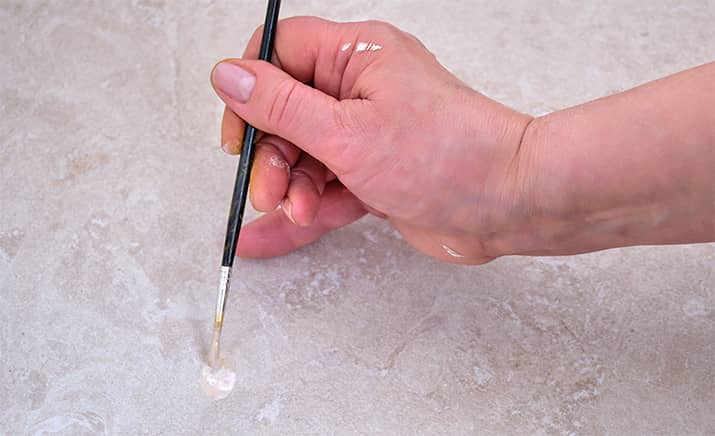Home
How to Fix Cracked Tile: From Hairline Fractures to Major Fissures
You’ve spent years curating beautiful furniture pieces and carefully cultivating a one-of-a-kind aesthetic in your home, the last thing you want to deal with is a blemish in your tile. Even though tiles used for your home’s flooring, backsplash, or shower surround are quite durable, they are still susceptible to damage. Whether they’ve been struggling to stand up to everyday wear and tear or you dropped a heavy object on your kitchen floor and cracked a tile, there’s no need to fret. Fixing a cracked tile is an easy home improvement project that nearly any do-it-yourselfer can take on and finish in a few short hours.
To help you determine the best method for fixing your cracked tile, the team at Kitchen Cabinet Kings has put together a quick guide showing you just how easy it is. Follow along to learn more about fixing (or replacing) a cracked tile.
How to Fix Cracked Backsplash or Floor Tile

No matter where you have ceramic or glass tile installed in your home, you may find yourself dealing with a crack. It’s easy to get upset about the flaw in your home design but luckily there are a few easy steps you can take to restore your tiling.
Assess the Damage
How big is the crack in your tile? This is the first question you want to ask before getting started because it will determine if you can restore the tile by filling the crack or if you need to fully replace the broken tile. If you’re dealing with a small hairline fracture, we’ll guide you through the steps you can take to make the blemish less noticeable. However, if you are dealing with a large crack or a completely shattered tile, a tile replacement may be in your future. While preparing for your tiling project, keep your family away from the area to prevent the crack from worsening before you have a chance to fix it.
Clean the Tile

Before we begin filling the hairline crack, you will want to begin by thoroughly cleaning the damaged tile and the surrounding area. Creating a clean slate will ensure that the epoxy will more easily adhere to the floor, resulting in a seamless repair job. We recommend dusting and vacuuming, as well as using a degreaser. Be sure to allow the area to completely dry before moving on to the next step.
Create an Epoxy Mixture
Head to your favorite local hardware store and purchase a two-part epoxy that will help fill the crack and hold the broken pieces of tile together. Any cracked tile filler will work similarly as well. Before mixing the two parts together to create your epoxy mixture, we recommend putting on gloves and a face mask to keep yourself safe from any of the chemicals and fumes. Then, create the epoxy mixture once you are ready to move on to the next step ? the mixture will begin hardening rather quickly so you need to be ready to move fast throughout the process.
Apply Epoxy to the Cracked Tile
Now that you’ve created the epoxy mixture, it’s time to work some magic and repair your damaged tile! Using a toothpick or small tool, place a small amount of the epoxy directly into the crack. The smaller the tool, the more exact you can be with the placement of the epoxy, limiting the amount of residual epoxy that will need to be cleaned up afterward. Spread a thin coat of the epoxy along the crack in the title, extending the mixture about a half centimeter on either side of the crack ? making sure to avoid getting epoxy on the grout! Once the crack has been covered with epoxy, allow it to sit for up to 15 minutes so it can dry fully.
Paint & Seal the Tile

Depending on how large the crack in your bathroom tile is, you may need to paint the epoxy-filled crack so the blemish isn’t noticeable. Your local hardware store can help you color-match the paint to your tile so the coverup isn’t noticeable. We recommend using an oil- or urethane-based paint for protection results. After the paint has dried, apply a sealer over the top of the repaired tile for added strength.
Schedule Professional Repair
If your floor or backsplash tile was only mildly damaged with a hairline fracture, then these steps should solve your problem! However, if you are dealing with more severe damage like a shattered floor tile, you may need to replace the entire tile instead.
For larger tile repairs or replacements, we always recommend calling a local handyman to determine the best course of action. They’ll help you determine if the kitchen or bathroom tile can be salvaged with epoxy or if a new tile is needed.
Frequently Asked Questions
What is the most durable type of tile?
You can choose from a variety of tile options for your home improvement project, including glass, ceramic, porcelain tile, and more. If you’re looking for a durable option, we often recommend porcelain tile due to its hard composition and resistance to scratches, stains, and water damage. Its durability makes it less likely to chip or crack so you can have peace of mind and enjoy its beauty for many years.
Can you fix a cracked tile without replacing it?
Yes, as long as the crack isn’t substantial you can fill a cracked tile with epoxy or another type of tile filler. This will help strengthen the tile and adhere the two cracked pieces back together. Cracks larger than a hairline fracture may require total replacement.
Does cracked tile mean foundation problems?
At the first sign of a crack in your floor tile, it’s easy to jump to the conclusion that there are problems with your home’s foundation. Luckily, that isn’t always the case. While cracked floor tile may indicate a foundation issue, tiles are also susceptible to wear and tear ? especially in the cracked tile is in a high-foot-trafficked part of your home. However, if you notice many cracks forming, it may be time to call in a foundation expert to double-check.
Does homeowners insurance cover cracked tiles?
No two homeowners insurance policies are exactly the same so you need to read through your specific policy to find out what is covered. In many cases, tile damage caused by fire, water damage, or a fallen object will be covered. However, damage from everyday wear and tear is likely not.
![See your dream kitchen in 3D [GET YOUR FREE DESIGN]](https://cdn.kitchencabinetkings.com/blog/wp-content/uploads/see-your-dream-kitchen-in-3d.webp)
![Contractor Discount Program: Offering contractors and builders special volume discounts on all applicable orders [LEARN MORE]](https://cdn.kitchencabinetkings.com/blog/wp-content/uploads/contractor-discount-program.webp)
![Explore our photo gallery [GET INSPIRED]](https://cdn.kitchencabinetkings.com/blog/wp-content/uploads/explore-our-photo-gallery.webp)
![What everyone is saying about KCK [READ REVIEWS]](https://cdn.kitchencabinetkings.com/blog/wp-content/uploads/what-everyone-is-saying-about-kck.webp)
![Get a cabinet sample [SHOP SAMPLES]](https://cdn.kitchencabinetkings.com/blog/wp-content/uploads/get-a-cabinet-sample.webp)
![Pay over time, on your terms with Affirm [LEARN MORE]](https://cdn.kitchencabinetkings.com/blog/wp-content/uploads/pay-over-time-on-your-terms-with-affirm.webp)